Dong Thap is one of the typical lands for favored nature and rich specialties of the Southwest region of Vietnam. Coming to Dong Thap, you can enjoy the unique and attractive relics and landscapes, and enjoy the rich source of products favored by nature here. Vietnam Reviewer will suggest the top 10 tourist attractions in Dong Thap that you should not be missed.
Table of Contents
Top 10 famous tourist attractions in Dong Thap
Nguyen Sinh Sac Mausoleum Relic Site
- Address: 123/1 Pham Huu Lau, Ward 4, City. Cao Lanh, Dong Thap
If you have the opportunity to come back to Dong Thap, an address of historical sources you cannot fail to visit is the relic of the mausoleum of Pho Bang Nguyen Sinh Sac, the resting place of the great President Ho Chi Minh’s father. After many years have passed, modified, and rebuilt many times, the relic area of Nguyen Sinh Sac has become a relic site preserving the historical and cultural values of Dong Thap in particular and the region. The Mekong Delta in general has both modern and historical beauty. The relic site of Nguyen Sinh Sac’s tomb is located at 123/1, Pham Huu Lau street, ward 4, Cao Lanh city, Dong Thap province. The relic is the resting place of Vice Chairman Nguyen Sinh Sac (1862-1929), the father of President Ho Chi Minh. He was a patriotic Confucianist, a physician who loved the people, and lived a pure and benevolent life all his life, taking care of the country for the people.
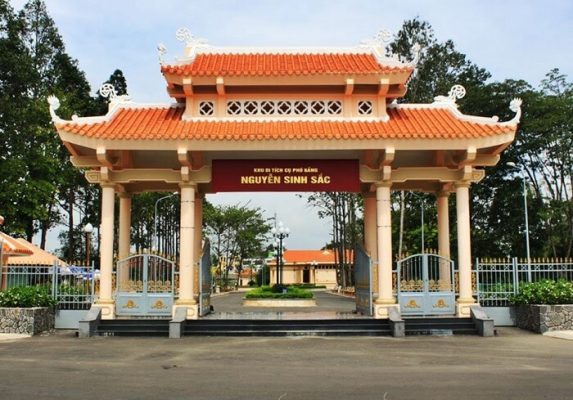
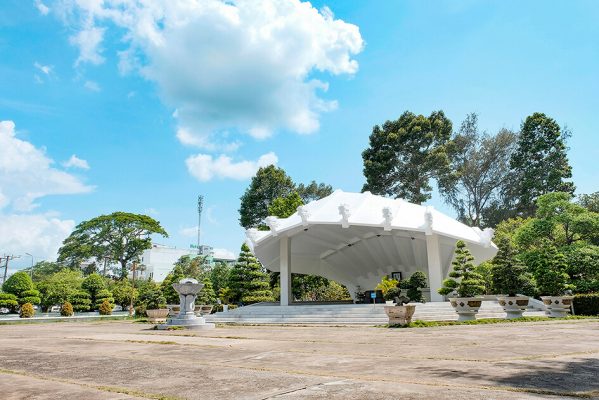
The Nguyen Sinh Sac mausoleum relic was ranked at the national level on April 9, 1992. The architecture of the most important relic site is the grave of Mr. Nguyen Sinh Sac. The grave is decorated with 9 innovative folk dragons reaching out in front of 9 gables, symbolizing the image of the people of the Mekong Delta protecting and embracing the grave. The architecture of the mausoleum also has other works such as a temple, a statue of Nguyen Sinh Sac, a gallery introducing the life of Mr. Nguyen Sinh Sac, Uncle Ho’s house on stilts, etc. Traveling in Dong Thap is a must. must visit the relic of Nguyen Sinh Sac’s mausoleum, and light a candle for Uncle Ho’s father.
Go Thap Relic Site
- Address: My Hoa and Tan Kieu communes, Thap Muoi, Dong Thap.
The Go Thap relic site is a national-level relic that has been recognized since 1998, containing many cultural-historical values of the nation and humanity. This place still has a complex of relics of the Kingdom of Funan more than 1,500 years ago, with relics of two periods of resistance against the French and against the US and many layers of folklore. Traveling to Dong Thap, coming here to find the roots, visitors will have interesting experiences, thereby more appreciating the contributions of the ancestors who went to open the realm. Go Thap consists of many small, low mounds located on sandy land, in the center of Dong Thap Muoi area, with a system of interlaced canals and a thriving Melaleuca forest ecosystem.
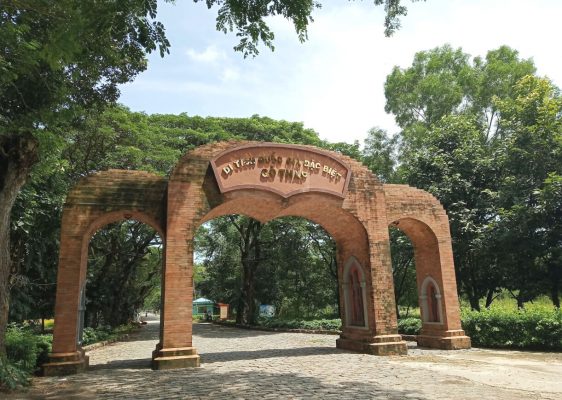

In particular, Go Thap is one of 34 “special national monuments” of Vietnam, one of two important historical and archaeological sites in the country (Central area of Thang Long Imperial Citadel and Go Thap relic – in Thap Muoi district, Dong Thap province).
Gao Giong Ecotourism Area
- Address: Gao Giong Commune, Cao Lanh, Dong Thap.
Gao Giong’s eco-tourism area is located in hamlet 6, Gao Giong commune, Cao Lanh district, Dong Thap province, about 15km from Cao Lanh city center. The eco-tourism area was established based on the Gao Giong Melaleuca forest (established in 1985). Up to now, the Gao Giong eco-tourism area has welcomed more than 300,000 visitors because of the gifts from nature and the results of reclamation and embellishment from the hands and minds of people. When coming to the eco-tourism area, visitors can admire the immense green of melaleuca, rice fields, and typical animals of the river such as storks, herons, cuckoos, etc. Ecological Gao Giong, visitors will have the opportunity to enjoy Dong Thap specialties: Grilled snakehead fish with young lotus leaves dipped in tamarind fish sauce, braised perch, sour fish cooked with rice with water lily, … with a sticky rice wine mixed with honey, in the fresh air, and leisurely.
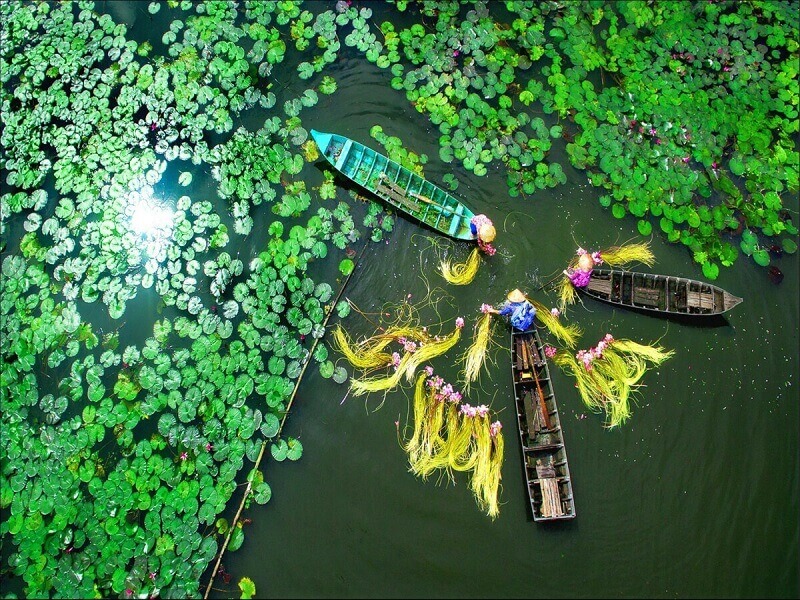
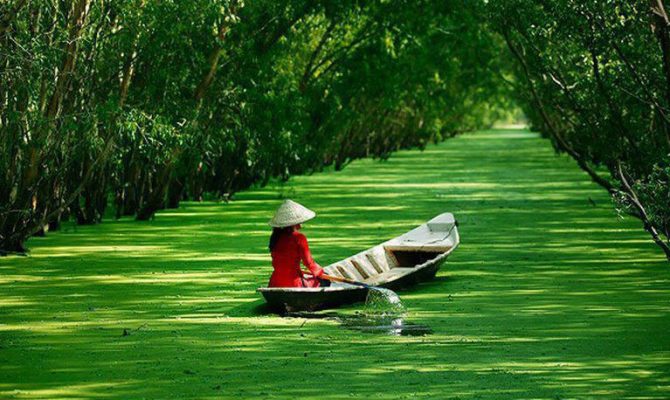
Known as the largest stork garden in the Dong Thap Muoi region, visitors here will admire and discover the life of birds. Every time the water season rises, the fields in Gao Giong are filled with storks, creating an extremely beautiful scene. And in the lotus valleys, there are thousands of red scorpions feeding and emitting catchy sounds and ravishing “performances”. Before visiting the bird garden, visitors will be given a pair of binoculars by the guide and invited to the 18m high observatory. Standing on the radio, visitors can see almost the entire bird garden and have an overview of the tourist area. After that, you will be taken to the bird garden by motorboat. When coming to the bird park, visitors will see with their own eyes many different species of birds, bringing a new and different feeling. It’s like you are in harmony with nature. Thanks to the rich source of seafood, visitors can enjoy the traditional specialties of the Dong Thap Muoi region. This is a tourist destination you should not miss when coming to Dong Thap.
Dong Sen Thap Muoi Eco-tourism Area
- Address: My Hoa Commune, Thap Muoi, Dong Thap.
Dong Sen Thap Muoi tourist area is located in My Hoa commune, Thap Muoi district, Dong Thap province, 39 km from Cao Lanh city. The special feature of Dong Sen Thap Muoi is that the lotus field is more than 11 hectares wide, gentle and pure. Here, visitors can experience the service of swimming by themselves in the middle of the vast lotus field, allowed to pick lotuses and popular accessories to take pictures. In the peaceful atmosphere at Dong Sen Thap Muoi ecotourism area, tourists can enjoy the delicious dishes of the countryside from lotus: grilled snakehead fish wrapped in young lotus leaves, lotus chicken salad, lotus sticky rice, lotus tea,… Along with that are delicious dishes such as fish sauce hotpot, snakehead fish sour soup, braised perch, grilled mouse meat,…
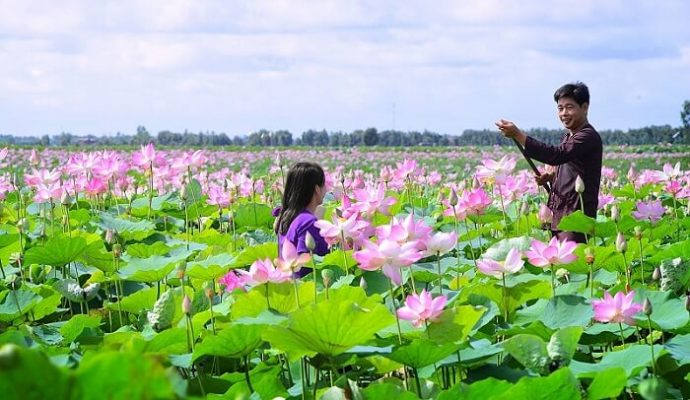

Surrounding the lotus area are wooden paths from one hut to another. In the middle of Dong Sen is a tall tower. From the top of the tower, you can see the surrounding rice fields stretching to the top. Visitors can also take a walk to see the lotus, breathe in the scent of the pink lotus… or borrow ao dai, baba, conical hat to unleash their creativity and save beautiful moments with friends. a relative. To the tourist area, if you want to move inside, you have to travel by canoe. The boat slowly drifts to take you inside, while walking you can enjoy the scenery along with the riverside and experience interesting and unique activities such as lotus picking, fishing, farming… You will recognize the beauty of the lotus – the national spirit of the homeland. The wind carries the fragrant lotus scent as a magical aroma to help relax the spirit.
Xeo Quyt Relic Site
- Address: My Hiep and My Long communes, Cao Lanh, Dong Thap.
Xeo Quyt relic site is located in My Hiep and My Long communes of Cao Lanh district, Dong Thap province, more than 30 km from Cao Lanh city, about 170 km from Saigon via National Highway 1A. The Xeo Quyt relic has a total area of 50 hectares, including 20 hectares of Melaleuca forest. The flora and fauna ecosystem here is rich and diverse with about 170 species of plants with 158 wild species and 12 species of woody plants, 200 species of wild animals. The special thing here is that there are 13 rare and precious flora and fauna species recorded in the Vietnam Red Book such as cobra, python, box turtle, broad-billed lemongrass bird… This place is also a revolutionary resistance base of the province. Dong Thap with A-shaped bomb shelters, Z-shaped battle tunnels, L-shaped secret bunkers,… Xeo Quyt relic site was restored on the background of ancient traces, a beautiful natural forest with green space, and was recognized as a national historic site in 1992.
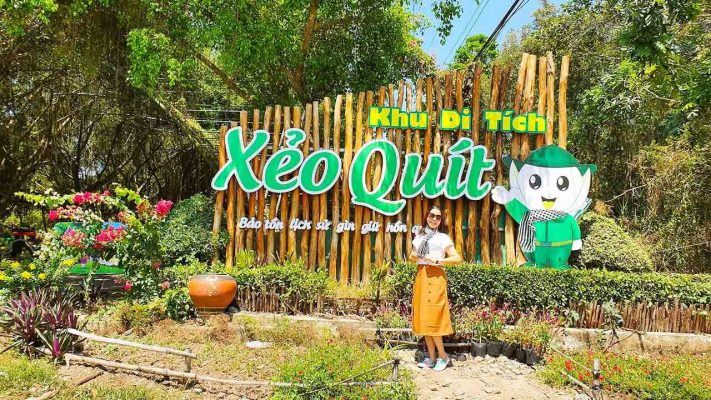
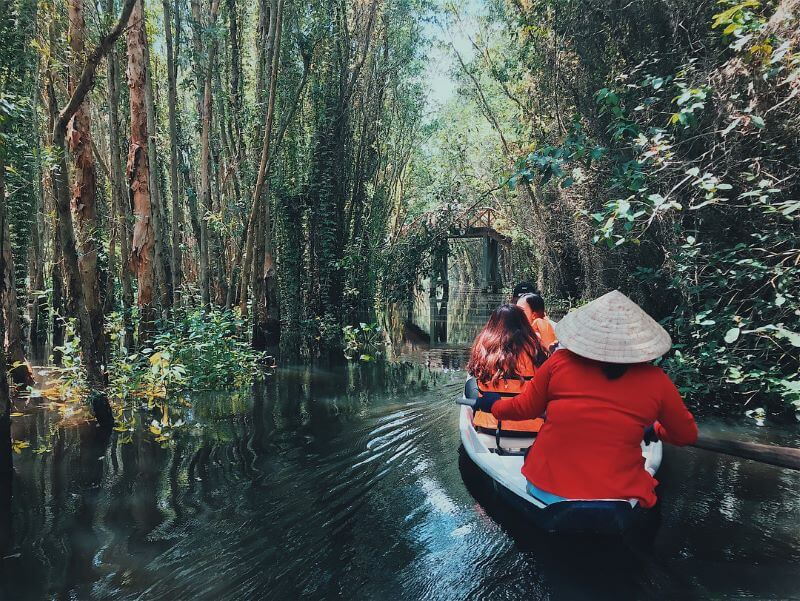
From diverse nature with the jungle to wonderful lotus ponds. To the historical values and delicious cuisine. All make a great feature for the Xeo Quyt tourist area. A destination for those who like peace. The natural beauty of the jungle garden is an interesting thing in Xeo Quyt. It is also known for being a large nature reserve. Especially as soon as you step in, the air is cool with the canopy covering the whole path. In particular, this place has many wonderful lakes and lotus ponds. In particular, there are also giant lotus leaves, which are quite beautiful to take pictures of. Or the wonderful blooming lotus ponds in the lotus season, where bridges are built directly to the lotus pond. You will have beautiful pictures to check in when coming here.
Tram Chim National Park
- Address: Tam Nong District, Dong Thap Province
Tram Chim National Park is located in the territory of 7 communes (Tan Cong Sinh, Phu Duc, Phu Tho, Phu Thanh A, Phu Thanh B, Phu Hiep), Tram Chim town in Tam Nong district. Tram Chim National Park with a total area of more than 7500 hectares is a typical miniature model of the Dong Thap Muoi region, with a diverse ecosystem, where visitors can discover the characteristics of the West River. This land of “six months of dry grass, burning grass, six months of flooded white fields” is the place where rich vegetation grows with more than 130 different species. The fauna here is outstanding with a rich waterfowl system consisting of 233 species, belonging to 25 genera, 49 families. Of which, 88% were found in the dry season, accounting for ¼ of the total number of bird species discovered in Vietnam. And especially the red-crowned crane, the largest in the family of cranes – an invaluable natural asset of Tram Chim National Park in Dong Thap.
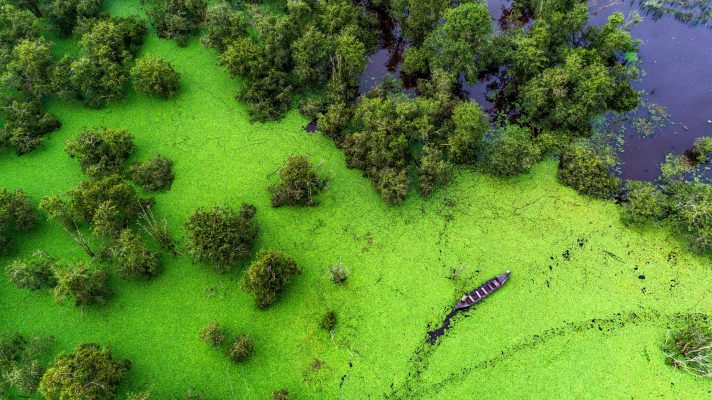
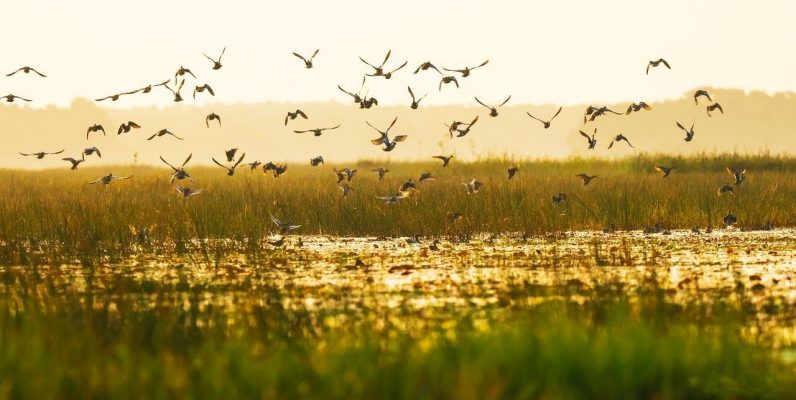
The fish system in Tram Chim National Park is equally rich, both playing the role of ecological balance and a source of food for birds. There are some fish species listed in the Red Book of Vietnam such as Com, Tiger Mang, Male Seahorse, Flying Fish, Et Moi, Ho fish, etc. By sustainably exploiting natural advantages in the industry. As a result of conservation efforts, Tram Chim National Park has been increasingly attracting tourists from near and far, because of its unique beauty and many interesting activities. One thing is certain anyone who has come to Tram Chim will be forever impressed by the scenery of the river, the specialties, and the love of the people here. The natural landscape and flora in Tram Chim National Park are very rich with more than 130 species of plants, the typical Melaleuca forest with the largest area (2968 ha) in the national park ecosystem. Coming to Tram Chim National Park, visitors can enjoy local specialties in an atmosphere of harmony and serenity with nature.
Ornamental flower village in Sa Dec flower city
- Address: Tan Qui Dong Commune, Sa Dec, Dong Thap.
Sa Dec flower village is located in the territory of Tan Qui Dong Commune, Sa Dec city, Dong Thap province, windy, fertile all year round, full of sunshine, is the land of hundreds of species of “heterosexual flowers”. This is one of the ornamental flower centers of the South, covering an area of 60 hectares with 600 households and 3,600 employees specializing in growing flowers and ornamental plants. In the spring days, hundreds of flowers in Sa Dec flower village jostle to bloom. Here selling all kinds of flowers of all colors and flavors such as roses, orchids, lilies, and ornamental plants with beautiful shapes. The atmosphere of thousands of blooming flowers will be a beautiful backdrop for perfect photos.
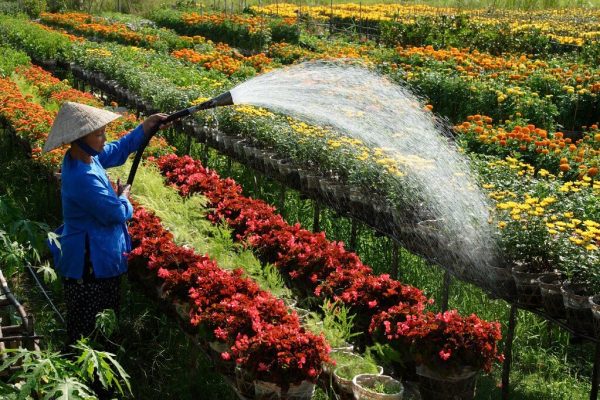
The history of Sa Dec flower village has been established since the early 20th century, at that time in the Tan Quy Dong area, only a few households planted flowers to decorate Tet. Seeing flowers in harmony with the land bloom beautifully, gradually the number of flower growing households has increased and business purposes are determined. Later, it spread to areas such as the Sa Nhien canal, An Hoa Ward, Tan Khanh Dong commune, and ward 3 of Sa Dec city. Up to now, the total flower growing area is more than 500 hectares, with over 2,300 households, 2,000 different species of ornamental flowers, becoming one of the largest ornamental flower baskets in the Mekong Delta and the South.
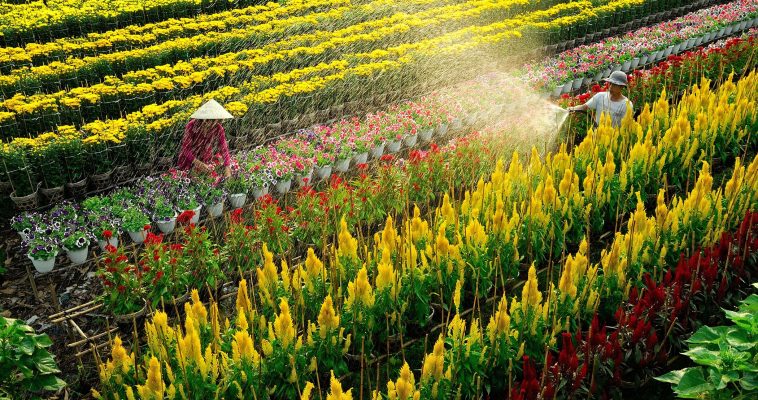
Previously, Tan Quy Dong ornamental flower village only operated under the model of “hereditary” and was not properly invested, so it has experienced many ups and downs. After entering the integration phase, having the opportunity to apply for scientific and technical advances, Tan Quy Dong flower gardens have flourished and have been invested in infrastructure, added many new and rare flower varieties, built building a breeding center for tissue transplantation, set up a wholesale market to consume ornamental flowers, etc. These factors have actively contributed to the development of Tan Quy Dong flower village, expansion, and entering the golden age.
Lai Vung Tangerine Garden
- Address: Lai Vung District, Dong Thap Province.
Lai Vung district, Dong Thap province is famous for its dreamy, fruit-laden tangerine gardens. If tourists want to see with their own eyes the garden of tangerines laden with fruit, they can go to 2 places to visit: Phuong Nghi point of gardener Dang Van Khanh and Ut Tuong point of gardener Nguyen Van Tuong. The garden is open from 8 am to 5 pm every day for tourists to freely visit, film, and take pictures. In Particular, you can enjoy Lai Vung specialties such as pink tangerines, sweet and sweet tangerines, and enjoy Lai Vung spring rolls in the unique Southern folk music space.
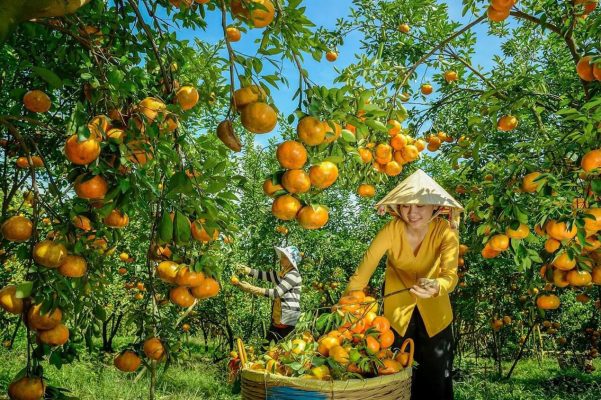
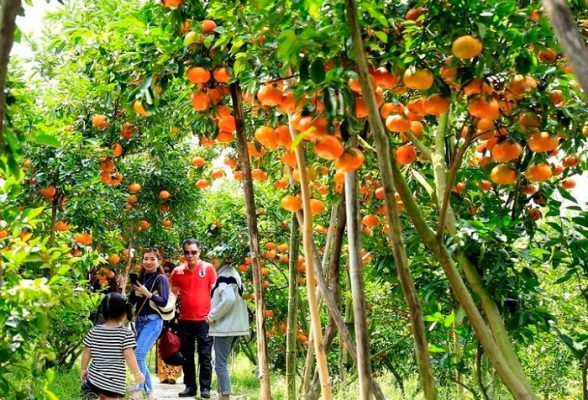
Coming to the tangerine garden on the occasion of Tet is the most perfect choice because, at this time, the tangerine garden in the fruit season is in full bloom, the natural colors are bright yellow, shiny, juicy… From Ho Chi Minh City, go in the direction of National Highway 1A through My Thuan Bridge. Continuing on Highway 80 will arrive in Lai Vung district, Dong Thap province. Lai Vung mandarin garden is usually in the season around Tet. At that time, the pink mandarin orchards changed clothes with water-filled mandarin oranges. The orange color is mixed with the green color of the garden of hundreds of mandarin trees. Visiting the tangerine garden, you can enjoy eating tangerines while discovering, taking pictures, and checking in is extremely interesting.
Huynh Thuy Le’s ancient house
- Address: No. 255A, Nguyen Hue Street, Sa Dec, Dong Thap.
Huynh Thuy Le ancient house is located in Sa Dec city, Dong Thap province, Vietnam. In addition to the combined value of East-West architecture, the old house is also famous for being associated with a borderless love affair of a French writer Marguerite Duras, and a rich Vietnamese-Chinese son Huynh Thuy Le in the early years of the 20th century. The house was originally the residence of Mr. Huynh Thuy Le’s family – the first lover of the French female writer, Marguerite Duras. This love later became a memoir for her to write the famous novel The Lover in 1984. This work was adapted by French director Jean-Jaques Annaud into a 1992 film L’Amant.
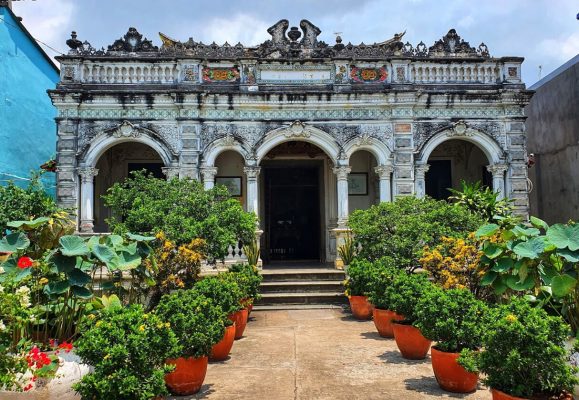
Initially, the house was built in the style of a traditional three-room house of the Southwest region, with an area of 258m2, with the main materials being precious wood and a boat-shaped roof with yin and yang tiles. Later, the house was restored with solid brick covering the inner wooden frame. Huynh Thuy Le’s ancient house attracts tourists by a borderless sad love of female writer Marguerite and her first lover, Mr. Huynh Thuy Le (owner of the old house). Come to Huynh Thuy Le’s ancient house to admire the beauty of ancient architecture that has been preserved to this day. Huynh Thuy Le’s ancient house was recognized as a national relic in 2009.
Kien An Cung Pagoda
- Address: Sa-Dec City, Dong Thap Province.
Kien An Cung Pagoda, also known as Ong Quach Pagoda, is over a hundred years old, located in the heart of Sa Dec city, one of Dong Thap’s tourist attractions attracting a large number of visitors. This typical architectural work of Chinese culture was recognized as a national historic site in 1990. The temple was built by a group of Chinese people in Fujian province (China) who settled in Sa Dec to worship. ancestors and educate their descendants, also to link the community, meet, discuss business, exchange information. The pagoda was started in 1924 and completed in 1927.
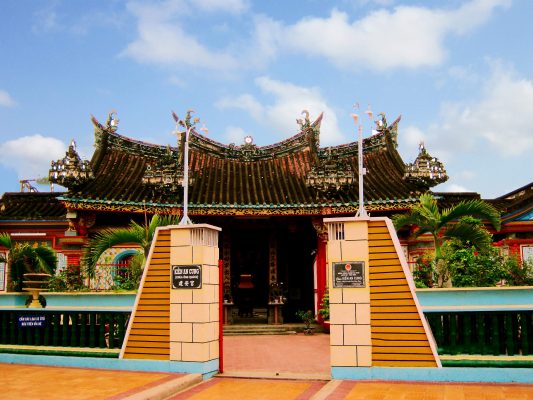
The unique feature of the pagoda is the fence built of cement but made like wild green bamboo poles. Coming to this relic, you will admire a unique, splendid, and solemn architecture. The pagoda faces the Cai Son canal, built in the majestic and superficial style of the word “Cong”. The whole pagoda has no truss, only the mortise arm to bear the force on round wooden pillars as pillars. The facade of the pagoda is designed in harmony with 3 main compartments, the yin and yang tile roof is roofed in the style of dragon waves, spreading the ground for 6 high waves, but those 6 waves are 6 magnificent and magnificent palaces. is minimized, symbolizing the spirit of overcoming difficulties and achieving success.
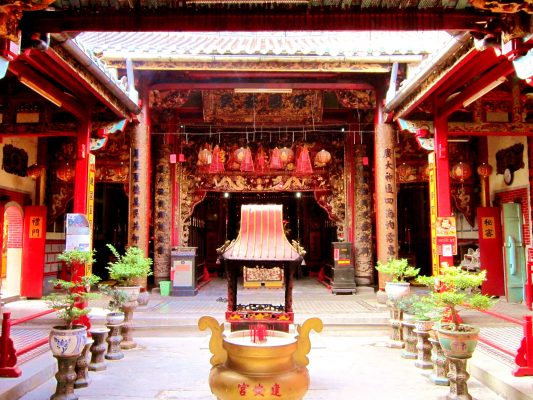
Coming to Kien An Cung, visitors have the opportunity to admire and admire the masterpieces of wood carving. Those are the sacks stretching below the ceiling of the pagoda, connecting the pillars. All are performed by the talented hands of Chinese folk artists. They also use important materials such as greenstone as door sills, incense burners, etc., brought from the ancient country. After nearly a hundred years of dust, the temple still looks superficial and the drawings still do not fade, it is the talent of the skilled craftsmen in the past.
Related Article: Discover Can Tho with top 10 famous tourist destinations
Above are suggestions for unique and interesting tourist attractions for tourists when coming to Dong Thap. Wish you and your family have a happy trip. If you have any feedback or need help, please send an email through vietnamreviewer.contact@gmail.com!

